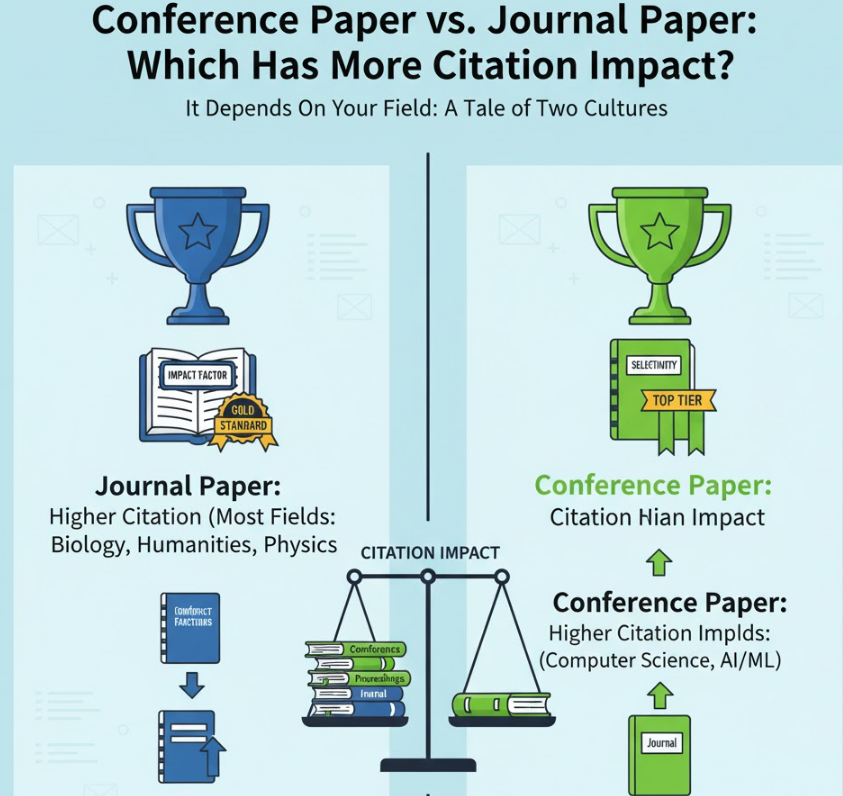

131 views||Release time: Oct 30, 2025
In the academic world, "publish or perish" is a well-known mandate. But where you publish can be just as important as what you publish. A common question for researchers, especially early in their careers, is whether to prioritize a conference paper or aim for a full journal article.
When measured by citation impact—the frequency with which a paper is cited by other scholars—the answer is nuanced and reveals a major divide between academic disciplines.

For most fields, the answer is clear. For one major field, the answer is the complete opposite. Here’s the breakdown.
For the vast majority of academic disciplines, including the humanities, life sciences (like biology and medicine), social sciences, and many physical sciences (like chemistry), the hierarchy is unambiguous:
Journal papers are the gold standard and have a significantly higher citation impact.
There are several key reasons for this:
Rigorous Peer Review: A journal article typically undergoes a lengthy and rigorous peer-review process, often involving multiple rounds of revisions.
The "Final Version": In these fields, a conference paper is often considered a "first look" or preliminary data. It's a way to get quick feedback from the community. The full, complete, and archival version of that research is expected to be published later in a journal.
Comprehensive Indexing: Major citation databases like Web of Science and Scopus have historically focused on indexing journal articles. This means journal papers are more visible and discoverable to other researchers over the long term, leading directly to more citations.
Perceived Prestige: Due to the rigorous review and archival nature, journal publications carry more weight in hiring, promotion, and grant-funding decisions in these fields.
The rule above is completely inverted in Computer Science (CS) and many related fields like Artificial Intelligence (AI), Machine Learning (ML), and Human-Computer Interaction (HCI).
In Computer Science, top-tier conference papers are more prestigious and often have a higher citation impact than most journal articles.
This unique culture evolved for one primary reason: speed.
Pace of Innovation: The field moves too quickly to wait 6-12 months for a journal's review process. A conference, with its fixed deadlines and 1-2 month review cycle, is the only way to disseminate cutting-edge research in a timely manner.
Extreme Selectivity: Because they are the primary outlet, top CS conferences (e.g., NeurIPS, ICML in AI; CHI in HCI; STOC in theory) have extremely rigorous peer-review processes. It is not uncommon for a paper to have 5-6 reviewers, and acceptance rates can be as low as 8-20%, making them more selective than many top journals.
Community Focus: These conferences are not just presentations; they are the central hub for the entire community to meet, debate, and set the agenda for the next year of research.
Indexing Acknowledgment: Citation indexes for CS, like CiteSeerX and Google Scholar Metrics, are built to recognize the importance of conference proceedings, ensuring these papers are tracked and cited just as heavily (or more so) than journal articles.
In these fields, journal articles are often seen as "extended versions" of conference papers, published much later as an archival formality, or as a place for broader review-style articles.
| Feature | Journal Paper (Most Fields) | Conference Paper (Most Fields) | Top-Tier CS Conference Paper |
| Primary Goal | Archival, "final" record of research | Preliminary findings, feedback | Disseminate cutting-edge, new results |
| Peer Review | Rigorous, multi-round, lengthy | Faster, often less rigorous | Extremely rigorous, fast, highly selective |
| Perceived Prestige | Very High | Low to Medium | Very High (often > journals) |
| Citation Impact | Highest | Lower | Very High |
| Example Fields | Biology, Medicine, Humanities, Chemistry | Biology, Medicine, Humanities, Chemistry | Computer Science, AI, Machine Learning |
So, which has more citation impact? The answer is: it depends entirely on your discipline.
If you are in the life sciences, humanities, or most physical sciences, your primary goal for high-impact, citable work should be a peer-reviewed journal article.
If you are in computer science or AI, your career and citation count will be built on publishing in top-tier, highly selective conferences.
Ultimately, the best strategy is to observe the senior researchers in your specific sub-field. Where do they publish their most important work? The answer will tell you exactly where to aim.